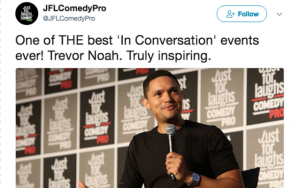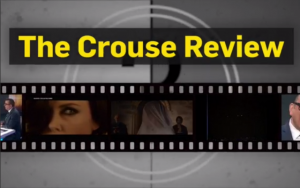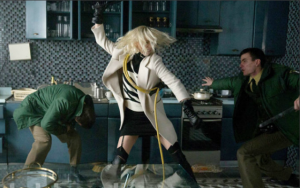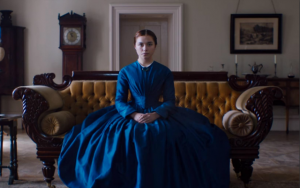
By Richard Crouse – Metro In Focus
“I got offered a lot of stuff in action movies that was either the girl behind the computer or the wife,” says Charlize Theron.
That was then, this is now. After dipping her toe in the action genre with Aeon Flux and Mad Max: Fury Road, the South African actress is kicking butt and taking names in Atomic Blonde, a wild spy thriller Variety calls “a mash-up of The Bourne Identity and Alias.”
Based on Antony Johnston’s 2012 graphic novel The Coldest City, it’s a Cold War thriller about an undercover MI6 agent sent to Berlin to investigate the murder of a fellow agent. “I didn’t just want to play a girly spy who depends on her flirty ways,” she says.
To prepare for the gruelling shoot Theron worked with eight personal trainers who taught her the stunt work.
“‘We’re going to pretend to do that, right?’” she asked director David Leitch during the preparation. “David was like, ‘No you’re actually going to throw big dudes.’ Alright, let’s throw some big dudes.”
Throwing big dudes around like rag dolls may look great on film but was a physical challenge for Theron. The Oscar winner twisted her knee, bruised her ribs and clenched her teeth so hard while shooting one of the over-the-top fight scenes she cracked two teeth, requiring dental surgery.
Theron joins a list of dangerous distaff action stars like Gal Gadot (Wonder Woman), Scarlett Johansson (Lucy, The Avengers), Michelle Yeoh (Crouching Tiger, Hidden Dragon), Jenette Goldstein (Aliens), Angelina Jolie (Wanted, Salt, Mr. & Mrs. Smith, Lara Croft: Tomb Raider), Milla Jovovich (Resident Evil) and Uma Thurman (Kill Bill, Parts 1 & 2) who give Jason Statham and Dwayne Johnson a run for their money.
All of those women owe a debt to two female action stars. Pam Grier and Tura Satana were larger-than-life pioneers, opening cans of whoop-ass on screen at a time when that was primarily the purview of the boys.
Quentin Tarantino directed Grier in Jackie Brown and says she may be cinema’s first female action star. Her films, like Foxy Brown and Sheba, Baby suggest he’s right. Grier could deliver a line and a punch, attributes that allowed her to cut a swathe in the male-dominated action movie market of the 1970s.
Perhaps the wildest female action movie of all time is 1965’s “ode to female violence,” Faster, Pussycat! Kill! Kill! starring Tura Satana as the thrill-seeking go-go dancer Varla.
Experienced in martial arts, Satana did her own stunts and brought her unique style — black leather gloves, Germaine Monteil eyeliner and layers of Max Factor makeup — to the film.
She also supplied some of the movie’s most memorable lines.
When a gas station attendant ogles her cleavage while extolling the virtues of being on the open road and seeing America, Satana ad libbed, “You won’t find it down there, Columbus!”
Time critic Richard Corliss called Satana’s performance “the most honest, maybe the one honest portrayal in the (director Russ) Meyer canon and certainly the scariest.”
“I took a lot of my anger that had been stored inside of me for many years and let it loose,” Satana said of her most famous role. “I helped to create the character Varla and helped to make her someone that many women would love to be like.”
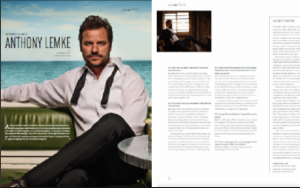 From Sotheby’s International Realty RESIDE Magazine: “Anthony Lemke’s reach is worldwide. As cocky mercenary Marcus Boone on the hit space opera Dark Matter he is seen in 160 countries around the world. Off screen he travels the world as an Official ambassador in Canada for Handicap International. Recruited by a chum from law school—that’s right, he’s also a lawyer—he lobbies for reducing the impact of armed conflicts on innocent civilians in regions ravaged by the use of explosive weapons…” Read the whole thing HERE!
From Sotheby’s International Realty RESIDE Magazine: “Anthony Lemke’s reach is worldwide. As cocky mercenary Marcus Boone on the hit space opera Dark Matter he is seen in 160 countries around the world. Off screen he travels the world as an Official ambassador in Canada for Handicap International. Recruited by a chum from law school—that’s right, he’s also a lawyer—he lobbies for reducing the impact of armed conflicts on innocent civilians in regions ravaged by the use of explosive weapons…” Read the whole thing HERE!